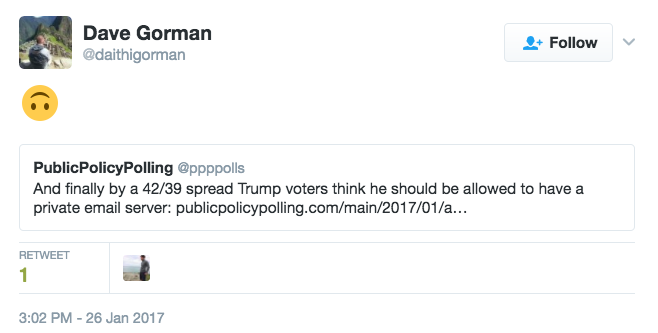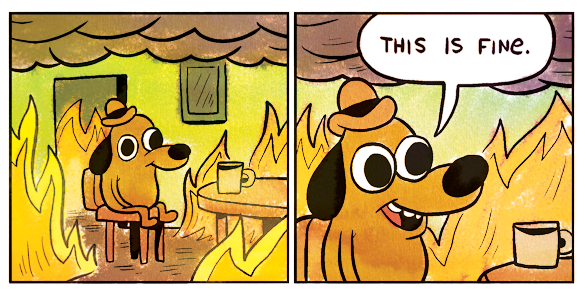Let’s talk emoji. (Side note: I’ve wondered for a while whether the plural of “emoji” is “emoji” or “emojis,” and it turns out both are acceptable. I’ll stick with “emoji” because I like to think of it as a mass noun. A sea of emoji.)
Over the past few months I’ve noticed a trend in the use of the upside-down smile emoji, i.e. this guy: 🙃. What I find particularly interesting is that I was able to pick up on the meaning of it right away, unlike a lot of other trending emoji. (I confess I’m still not 💯% sure what 💯 means.)
Most emoji are primarily what C.S. Peirce would call iconic, which is to say they resemble the things they represent. Your standard smiley (😀 ) looks like a smiling face. 🔥 looks like fire. 💩 looks like a very neatly-excreted poo that for some reason has eyes and a mouth. (Wait, if the poop has a mouth, then presumably the poop has a gastrointestinal system, so does that mean that the poop… poops?)
But when people use emoji, they’re not necessarily using them as straightforward iconic signs. If I were to use the sunglasses face (😎 ) in a text message, it probably wouldn’t mean “I’ve just put my sunglasses on.” And if I were to tweet “Just watched Tom Hardy in Warrior 🔥🔥🔥” it probably wouldn’t mean that I caught on fire after the movie ended. (If I were on fire I’d probably use this emoji: 😱 )
In use, emoji are primarily indexical, which is to say they refer to adjacent or causally-connected concepts. 😀 doesn’t just represent a smiling face, it represents happiness — something that’s causally associated with a smiling face. 🔥 doesn’t just represent fire, it represents all the metaphorical associations of heat.
With repeated use, many emoji take on conventional meanings. So people are unlikely to use 🔥 to indicate, say, anger, because enough people have used it to signify lust that that’s become its primary association.
So, where am I going with all this? Well, a lot of the face emoji are pretty straightforward in terms of their meanings. They resemble facial expressions, and people use them to substitute for the lack of actual visual feedback in computer-mediated communication. They act as cues, letting the reader know how to interpret the accompanying text (or lack thereof).
But — and here we’re finally getting to the point — the upside-down smiley does not correspond to any real-life facial expression. There’s no emotion that you convey by turning your head upside-down. We can’t physically do that with our heads. Unless you have that thing from Back to the Future Part 2 that they used to dangle not-Crispin-Glover upside-down in order to hide his not-Crispin-Glover-ness. But I’m assuming you don’t have that thing.
So what does the upside-down smiley mean? Emojipedia, which is apparently a thing, describes it thusly:
A face that is upside-down, often representing a sense silliness or goofiness. Sometimes used as an ambiguous emotion, such as joking or sarcasm.
I think this description fails to capture the actual usage. Searching Twitter for the emoji in question yields plenty of examples that seem neither silly nor sarcastic:
Just got Jury duty 🙃
— Kail🌸 (@Kaileyfaith12) January 26, 2017
I’m so tired of this bullshit 🙃
— 🎃Beki Beaulieu🎃 (@winequeenn) January 26, 2017
Dear people who ride their bikes in the middle of the road: we all hate you 🙃
— Halee Sharp (@HaleeSharp13) January 26, 2017
And this concise political commentary:

None of these people seem like they’re being particularly “silly,” nor are they being sarcastic, exactly. A Bustle article about 🙃 describes it as indicating “snark,” which seems slightly closer to the money but not quite on it. Urban Dictionary suggests “You’re hiding your pain behind a smile” as one of the emoji’s definitions, which is plausible.
I think the best description comes from one of my students last semester, who described it as meaning “I’m smiling on the outside, but I’m dying on the inside.”
But why does it mean that? Did someone once arbitrarily choose to use it that way, and then it caught on? Or is there some kind of meaningful connection between the image and the meaning? I lean toward the latter, because it was so easy for me to pick up on the meaning of the emoji.
In general, turning an image upside-down does not have connotations of reversal; there aren’t really any examples (in American/Western semiotics, at least) where turning a signifier upside-down reverses the meaning of the signified. Smiles and frowns specifically are linked as inversions of one another, but to “turn one’s frown upside-down” does not mean to turn one’s entire head upside-down.
However, there is an example where turning the signifier upside-down indexes something about the situation in which the signifier is being displayed: the American flag.
Displaying the American flag upside-down, according to the U.S. Flag Code, should only be done “as a signal of dire distress in instances of extreme danger to life or property.” (I think this is probably intended for ships, because I can’t imagine that, were my life in danger in my home, one of my priorities would be going outside and changing the orientation of my flag.) People have used upside-down American flags as a form of political protest, to suggest that the country is in a dire or dangerous situation. (People have been arrested for doing so.)
The upside-down smiley, it seems to me, operates through the same modality. It’s a distress signal — a sign that all is not normal, that there is danger or pain lurking below the surface. It’s an insincere smile; a rictus; a signifier not just of rage or sadness but of bottled rage or sadness. It’s a more succinct version of K.C. Green‘s already-succinct comic panels that have become widely popular:

In a sense, the upside-down smiley is the literal sign of the times, capturing the zeitgeist in a few pixels. To quote Thomas Paine:
These are the times that try men’s souls. 🙃